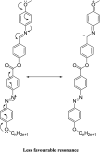New wide-stability four-ring azo/ester/Schiff base liquid crystals: synthesis, mesomorphic, photophysical, and DFT approaches
- PMID: 35866044
- PMCID: PMC9261499
- DOI: 10.1039/c9ra10499b
New wide-stability four-ring azo/ester/Schiff base liquid crystals: synthesis, mesomorphic, photophysical, and DFT approaches
Abstract
New four-groups-based azo/ester/Schiff base liquid crystals, ((4-substitutedphenylimino)methyl)phenyl 4-[2-(4-alkoxyhenyl)diazenyl]benzoate, In a-d, were synthesized and analyzed for their mesomorphic stability and optical activity. In these compounds, a terminal alkoxy group of variable chain length from n = 6 to n = 16 carbons is attached to the end of a phenylazo benzoate moiety and the other end of the molecules is connected to a different polar compact substituent X (CH3O, CH3, H, and Cl). FT-IR, 1H NMR, mass spectroscopy and elemental analysis were carried out for molecular structure confirmation of the prepared compounds. The mesomorphic properties were confirmed using a combination of differential scanning calorimetry (DSC) and polarized light microscopy (PLM). The photophysical property was studied by UV-vis spectroscopy. All the prepared homologous series exhibited high thermal stability with a wide-temperature mesomorphic range. The thermal and geometrical parameters of the investigated compounds were estimated by density functional theory (DFT). The results revealed that all the compounds were not completely planar with a relatively high twisting moiety at the CH[double bond, length as m-dash]N part and their twist angles were affected by the electronic nature of the attached X group. Moreover, the calculated quantum chemical parameters as determined by the DFT approach of the investigated compounds were related to the experimentally determined values of the mesophase thermal stability (T c) and mesophase temperature ranges (ΔT SmA and ΔT N) as well as the type of the mesophase.
This journal is © The Royal Society of Chemistry.
Conflict of interest statement
There are no conflicts to declare.
Figures

















Similar articles
-
The Synthesis of New Thermal Stable Schiff Base/Ester Liquid Crystals: A Computational, Mesomorphic, and Optical Study.Molecules. 2019 Aug 21;24(17):3032. doi: 10.3390/molecules24173032. Molecules. 2019. PMID: 31438540 Free PMC article.
-
Physical and Thermal Characterizations of Newly Synthesized Liquid Crystals Based on Benzotrifluoride Moiety.Materials (Basel). 2023 Jun 10;16(12):4304. doi: 10.3390/ma16124304. Materials (Basel). 2023. PMID: 37374488 Free PMC article.
-
Synthetic, Mesomorphic, and DFT Investigations of New Nematogenic Polar Naphthyl Benzoate Ester Derivatives.Materials (Basel). 2021 May 16;14(10):2587. doi: 10.3390/ma14102587. Materials (Basel). 2021. PMID: 34065725 Free PMC article.
-
Mesophase Behavior of Molecules Containing Three Benzene Rings Connected via Imines and Ester Linkages.ACS Omega. 2024 Jul 12;9(29):31601-31610. doi: 10.1021/acsomega.4c01564. eCollection 2024 Jul 23. ACS Omega. 2024. PMID: 39072071 Free PMC article.
-
Synthesis, Mesomorphic and Computational Characterizations of Nematogenic Schiff Base Derivatives in Pure and Mixed State.Molecules. 2021 Apr 2;26(7):2038. doi: 10.3390/molecules26072038. Molecules. 2021. PMID: 33918482 Free PMC article.
Cited by
-
New Nitro-Laterally Substituted Azomethine Derivatives; Synthesis, Mesomorphic and Computational Characterizations.Molecules. 2021 Mar 30;26(7):1927. doi: 10.3390/molecules26071927. Molecules. 2021. PMID: 33808112 Free PMC article.
-
Induced Wide Nematic Phase by Seven-Ring Supramolecular H-Bonded Systems: Experimental and Computational Evaluation.Molecules. 2020 Apr 7;25(7):1694. doi: 10.3390/molecules25071694. Molecules. 2020. PMID: 32272753 Free PMC article.
-
New Symmetrical U- and Wavy-Shaped Supramolecular H-Bonded Systems; Geometrical and Mesomorphic Approaches.Molecules. 2020 Mar 20;25(6):1420. doi: 10.3390/molecules25061420. Molecules. 2020. PMID: 32245001 Free PMC article.
-
Design of Liquid Crystal Materials Based on Palmitate, Oleate, and Linoleate Derivatives for Optoelectronic Applications.Molecules. 2023 Feb 11;28(4):1744. doi: 10.3390/molecules28041744. Molecules. 2023. PMID: 36838732 Free PMC article.
-
A New Family of Benzo[h]Chromene Based Azo Dye: Synthesis, In-Silico and DFT Studies with In Vitro Antimicrobial and Antiproliferative Assessment.Int J Mol Sci. 2021 Mar 10;22(6):2807. doi: 10.3390/ijms22062807. Int J Mol Sci. 2021. PMID: 33802075 Free PMC article.
References
-
- Imrie C. T. Henderson P. A. Yeap G.-Y. Liq. Cryst. 2009;36:755–777. doi: 10.1080/02678290903157455. - DOI
-
- Yeap G.-Y. Lee H.-C. Mahmood W. A. K. Imrie C. T. Takeuchi D. Osakada K. Phase Transitions. 2011;84:29–37. doi: 10.1080/01411594.2010.513613. - DOI
-
- Yeap G.-Y. Osman F. Imrie C. T. Liq. Cryst. 2015;42:543–554. doi: 10.1080/02678292.2015.1004843. - DOI
-
- Yeap G.-Y. Hng T.-C. Yeap S.-Y. Gorecka E. Ito M. M. Ueno K. Okamoto M. Mahmood W. A. K. Imrie C. T. Liq. Cryst. 2009;36:1431–1441. doi: 10.1080/02678290903271504. - DOI
-
- Pramanik A. Das M. K. Das B. Żurowska M. Dąbrowski R. Liq. Cryst. 2015;42:412–421. doi: 10.1080/02678292.2014.996792. - DOI
LinkOut - more resources
Full Text Sources

